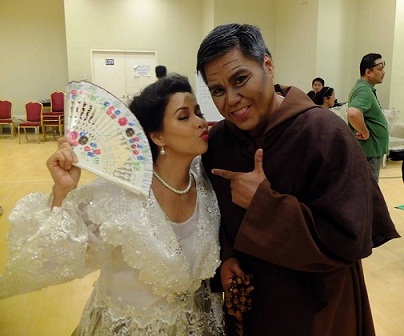
By PABLO A. TARIMAN
FELIPE Padilla de Leon’s opera, “Noli Me Tangere” has enjoyed several well-received revivals since its world premiere in 1957 at the FEU Auditorium.
One saw its grand staging at the CCP main theater in 1987 with the Maria Clara of Andion Fernandez, the Ibarra of Nolyn Cabahug and the Sisa of Fides Cuyugan Asensio (alternating with the equally brilliant soprano Luz Morete).
Tts chamber opera version was staged at UP’s Wilfredo Ma. Guerrero Theater under the direction of Alexander Cortez and enjoyed several performances. What I remember about this production is the memorable Padre Damaso of Jonathan Velasco and the angelic voice of a boy singing Basilio’s aria.
Watching the new revival of “Noli” at the gala night at the Resorts World last Thursday under the direction of Freddie Santos, one saw a grand production especially the stunning sets and costumes of Jerry Sibal framed by a stylish proscenium reflecting 18th century architecture.
There were many things working for this latest revival.
The 1,500-seat theater had the biggest LED screen in Asia and provided video backdrops that helped the opera’s idyllic setting more true-to-life like the crocodile showing up in the picnic of Maria Clara and friends.
Moreover, the stage – reportedly the widest in the Philippines – made the singers look diminutive.
But the two Euro-LED screens — equipped with 3D effects, a complex fly system and a revolving stage supported by good lighting and state-of-the-art digital audio system – magnified the images of the singers on both sides of the theater.
The English translation flashed all over the stage made the opera enjoyable even to foreigners.
With all these high-tech facilities, it was obvious singers need not exert extra effort to project; they just have to make sure their operatic voices didn’t sound too amplified.
(This is the same venue that had seen local revivals of The Sound of Music, The King and I, and Cinderella, among others.)
On the whole, the opera had the engaging and enigmatic Ibarra of tenor Sal Malaki who sang and acted with relish.

The Maria Clara of soprano Rachelle Gerodias evoked a tender, if, haunting “Kay Tamis Mabuhay” and Eggo Velasco was a revealing Basilio in the death scene of Sisa. The purity and youth of Basilio had less impact with the amplification that made his aria sound like it was sang by an oversized man (the Basilio in the UP production remains unforgettable).
The opera’s showstopper was no doubt soprano Antoni Mendezona who sang “Awit ng Gabi ni Sisa” with all the high notes clear and distinct as a bell and to boot, acting with desired intensity.
There is so much to be learned in the portrayal of baritone Andrew Fernando as Padre Damaso. For one, his singing tugged at the heart (even as his character was widely perceived as repulsive) and his scheming nature was felt inward rather than on the outside. For this opera fan, his prayer scene was the most moving part of the opera and it made people reflect on the human side of this widely hated character in Rizal’s novel.
The opera ended in the duet of Ibarra and Maria Clara which probably had less impact as most operas end with massive chorus.
But in the curtain call, the audiences came to life and gave its standing ovation to the Sisa of Mendezona. Hearty applause also went to the Basilio of Velasco and the Padre Damaso of Fernando.
The Manila Philharmonic Orchestra under Rodel Colmenar was — on the whole — singer-friendly and it had the rare insight of interpretation as it highlighted the romance and high drama of the opera.
On the whole, Santos’ direction showed a familiarity with the theater and he used them to make the opera more thrilling for non-opera fans. For another, he made sure the characters didn’t sound like museum figures from another century but almost like real life characters in today’s milieu.
As a true-to-life sidelight of the gala night, the grandniece of Jose Rizal, Gemma Cruz Araneta, was in the audience.

For the record, the De Leon opera had its world premiere in 1957 in the 1,040-seater FEU Auditorium, then moved on to the 1,800 seater CCP main theater in 1974 with the Ibarra of Don David, the Maria Clara of Ruby Salazar, the Sisa of Fides Cuyugan Asensio and the Padre Damaso of Aurelio Estanislao.
The 1987 revival courtesy of Asensio’s ’s Music Theater Foundation had the Ibarra of Nolyn Cabahug, the Sisa of Asensio (alternating with Luz Morete) and the Maria Clara of Andion Fernandez with the Philippine Philharmonic conducted by Oscar Yatco.
Baritone Nomer Son added that this same production with reduced performers toured the US in 1988 and was heard in Chicago, Detroit,St. Louis and Los Angeles.
The De Leon opera had its first New York run last year at the Kaye Playhouse of Hunter College in New York with an orchestra under the baton of Michael Dadap and presented by the Foundation for Filipino Artists, Inc led by its its chairperson, Loida Nicolas Lewis. It moved to Kennedy Center in Washington D.C. August this year to good notices.

For now, the real heroes of the opera are the producers — Loida Nicolas Lewis, Jerry Sibal, and Edwin Josue — who believed in the opera and what it can do to change the outlook of the young generation.
As another writer earlier noted, it takes balls to stage an opera in this country where most people have either no idea what opera is, or think it’s brain-meltingly boring. Indeed by spearheading the revival of this opera, the Noli producers “displayed the biggest, most operatic set of balls ever” by launching massive marketing effort to make sure every Filipino gets a chance to see this De Leon opus.
(For tickets to “Noli Me Tangere” which will run until September 28 visit TicketWorld (891-9999 or www.ticketworld.com.ph).


